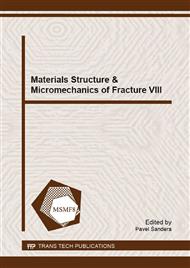p.485
p.489
p.495
p.501
p.506
p.514
p.518
p.522
p.526
Micro Mechanical Behaviors and Damage in Nickel Base Alloy and Steels during Very High Cycle Fatigue
Abstract:
Fatigue damage in a metallic material during very high cycle fatigue can strongly be correlated to the microstructure. This paper provides a review and a discussion on the micro damage behaviors in a nickel base alloy and three steels during very high cycle fatigue using micro plasticity and material mechanics. The results show that cyclic plastic deformation in these materials can occur very locally even with an applied stress that is much lower than the yield strength. The fatigue damage occurs mainly at grain or twin boundaries due to local impingement and interaction of slip bands and these boundaries. The crystallographic properties, Schmid factors and orientations of grain and boundaries have very important roles to the fatigue damage. Subsurface fatigue crack initiation in the matrix is one of the mechanisms for very high cycle fatigue. In the fine granular area, high plastic strain localization and cyclic plastic deformation can lead to dislocation annihilation and consequently formation of vacancies, or eventually nanopores at the subcell boundary that leads to fatigue crack initiation and propagation.
Info:
Periodical:
Pages:
506-513
Citation:
Online since:
December 2016
Authors:
Price:
Сopyright:
© 2017 Trans Tech Publications Ltd. All Rights Reserved
Share:
Citation:


